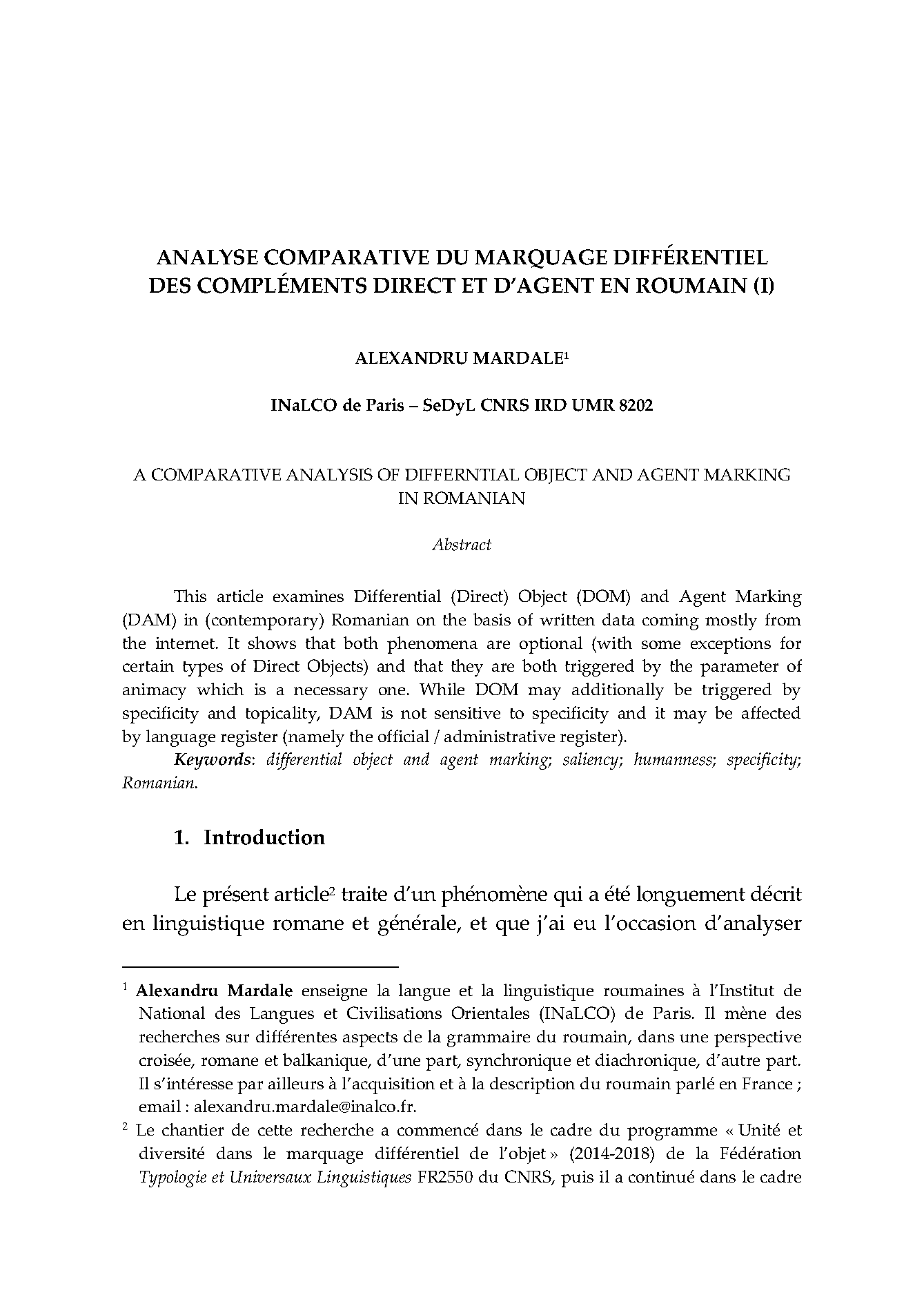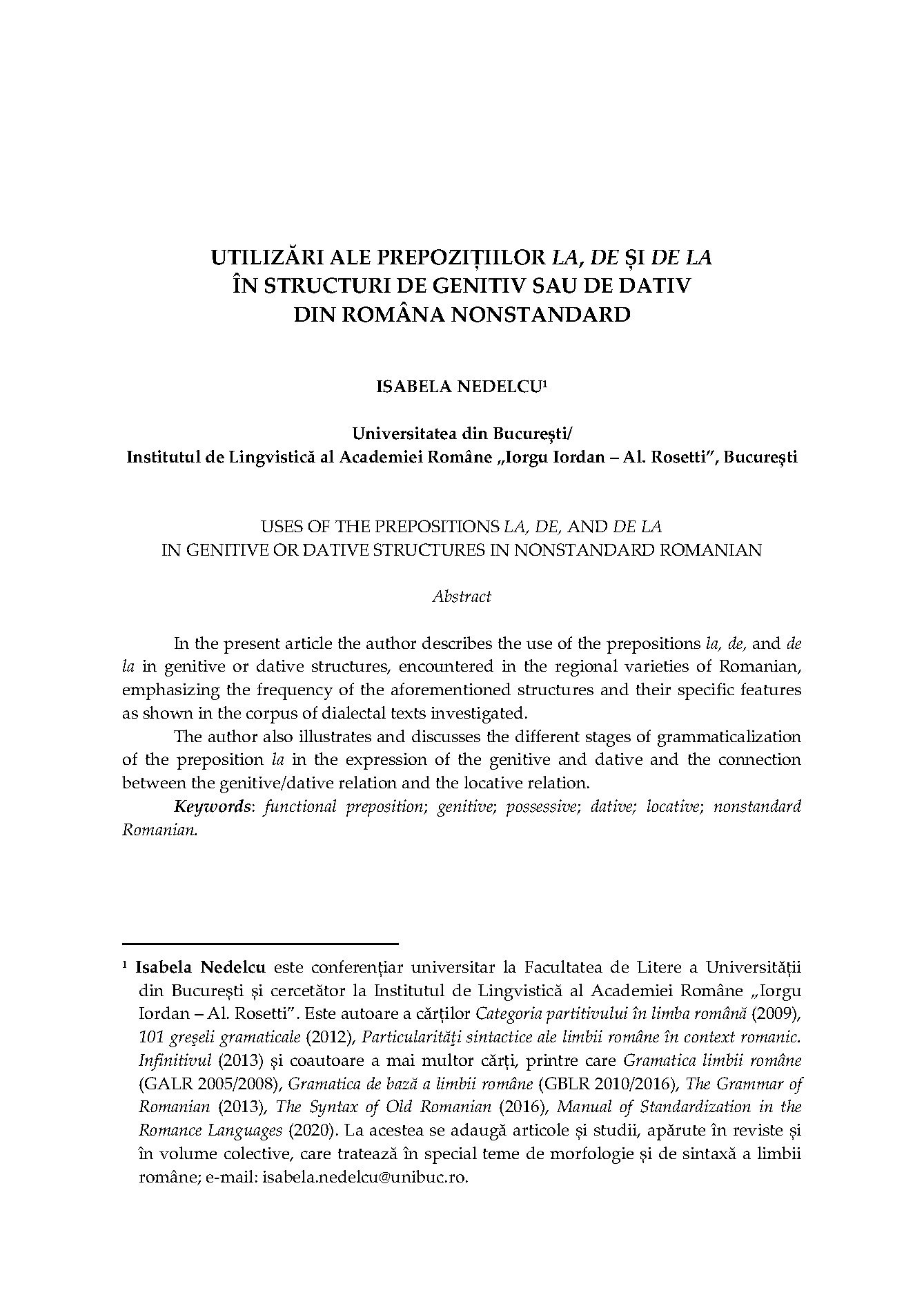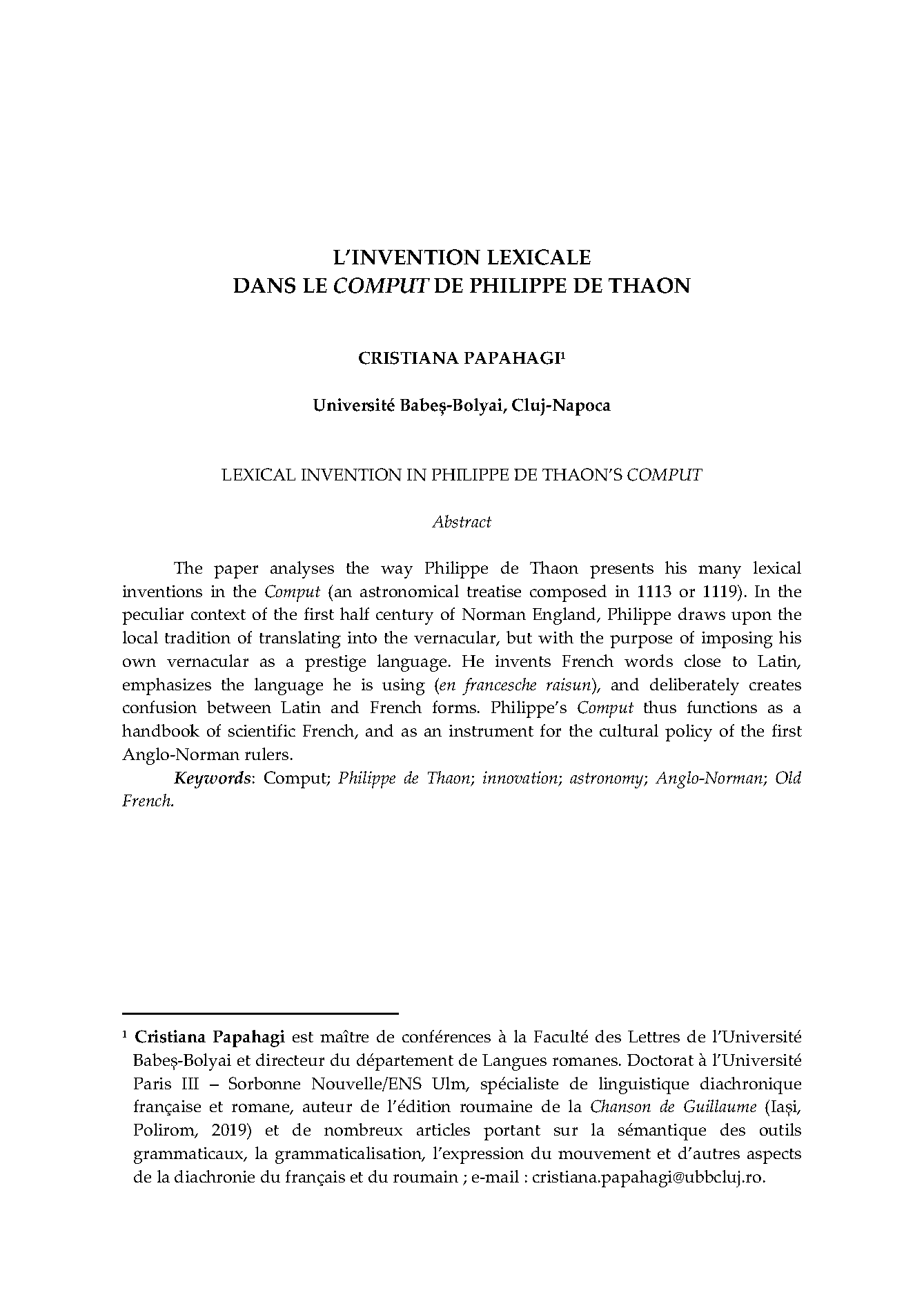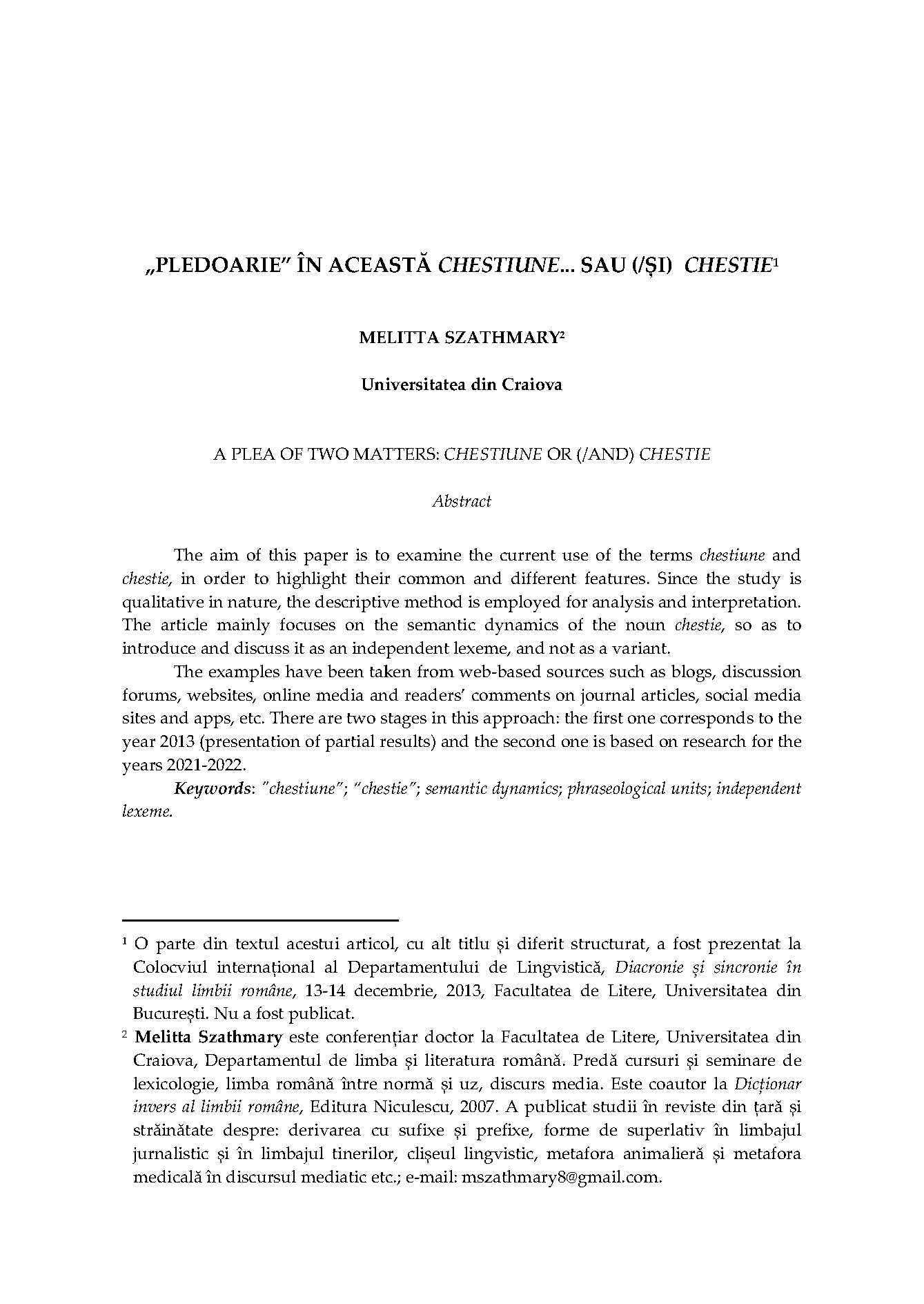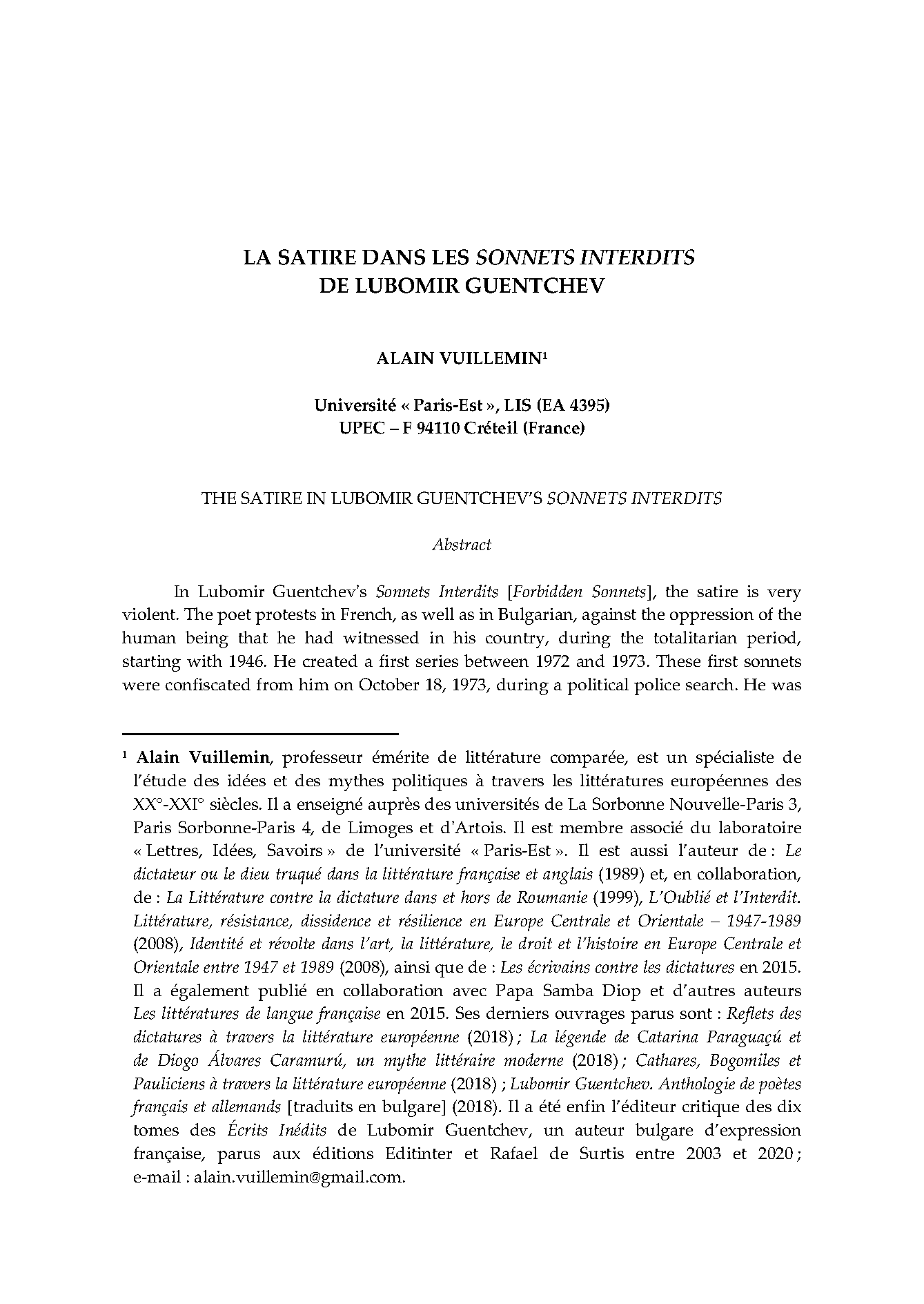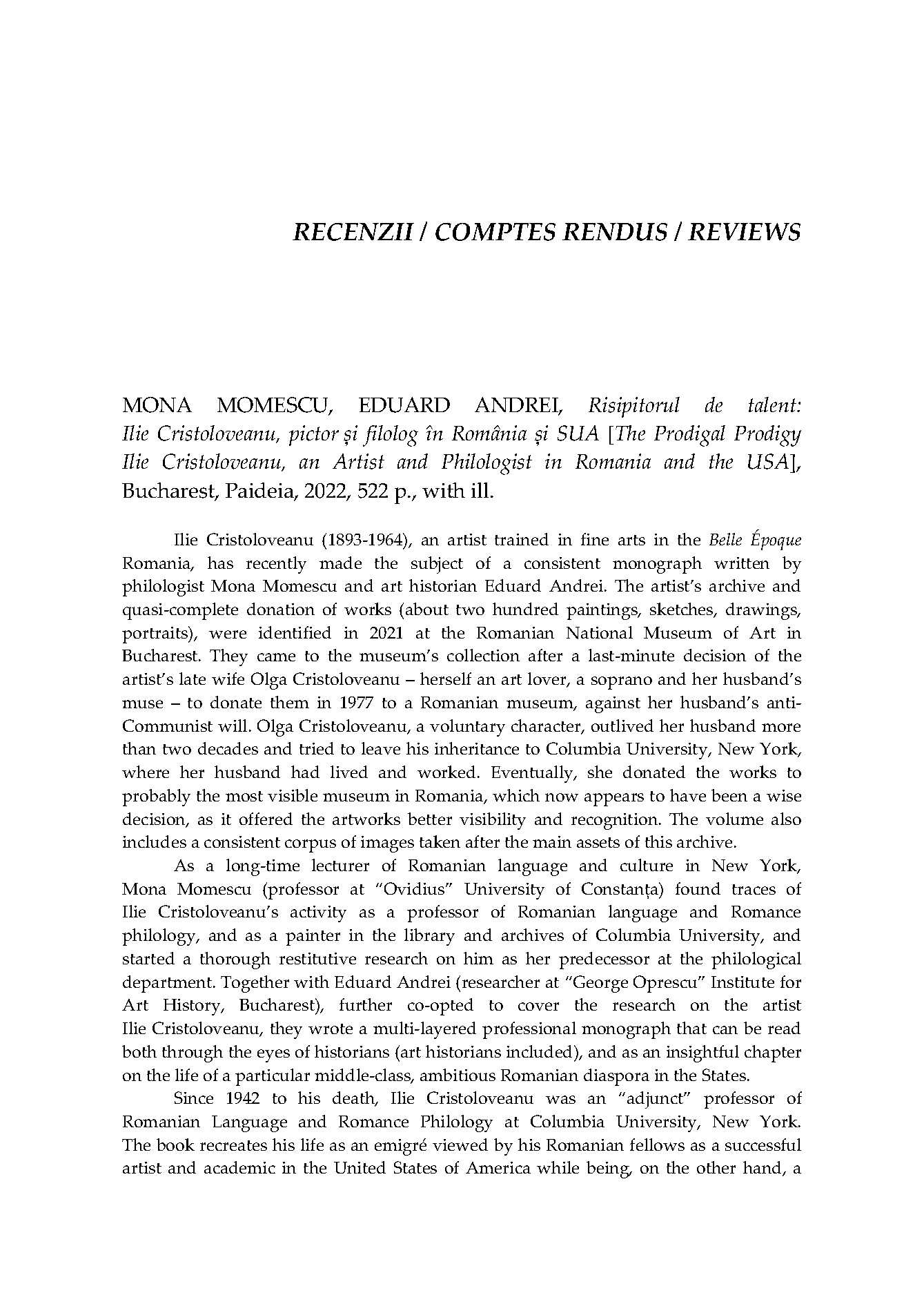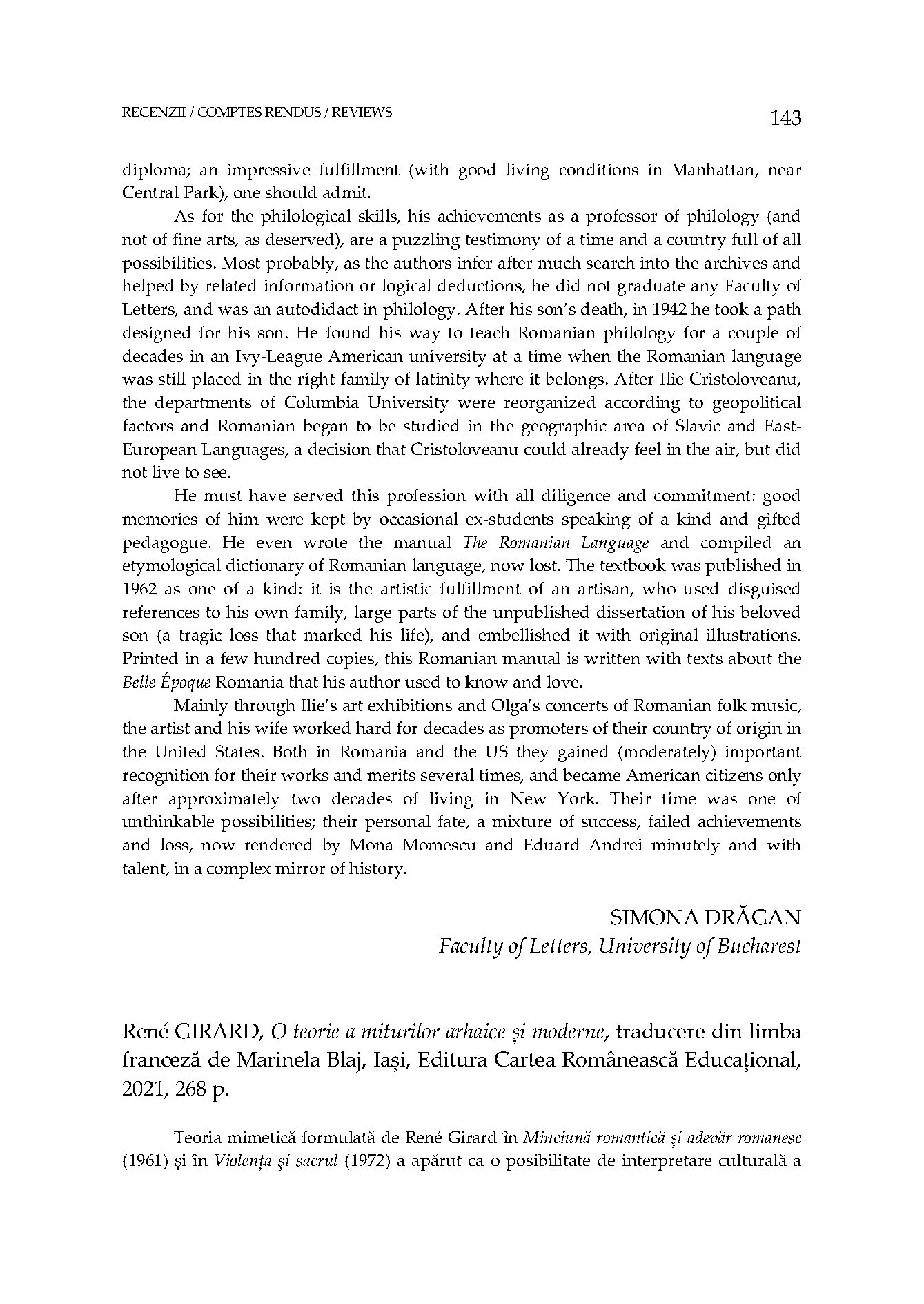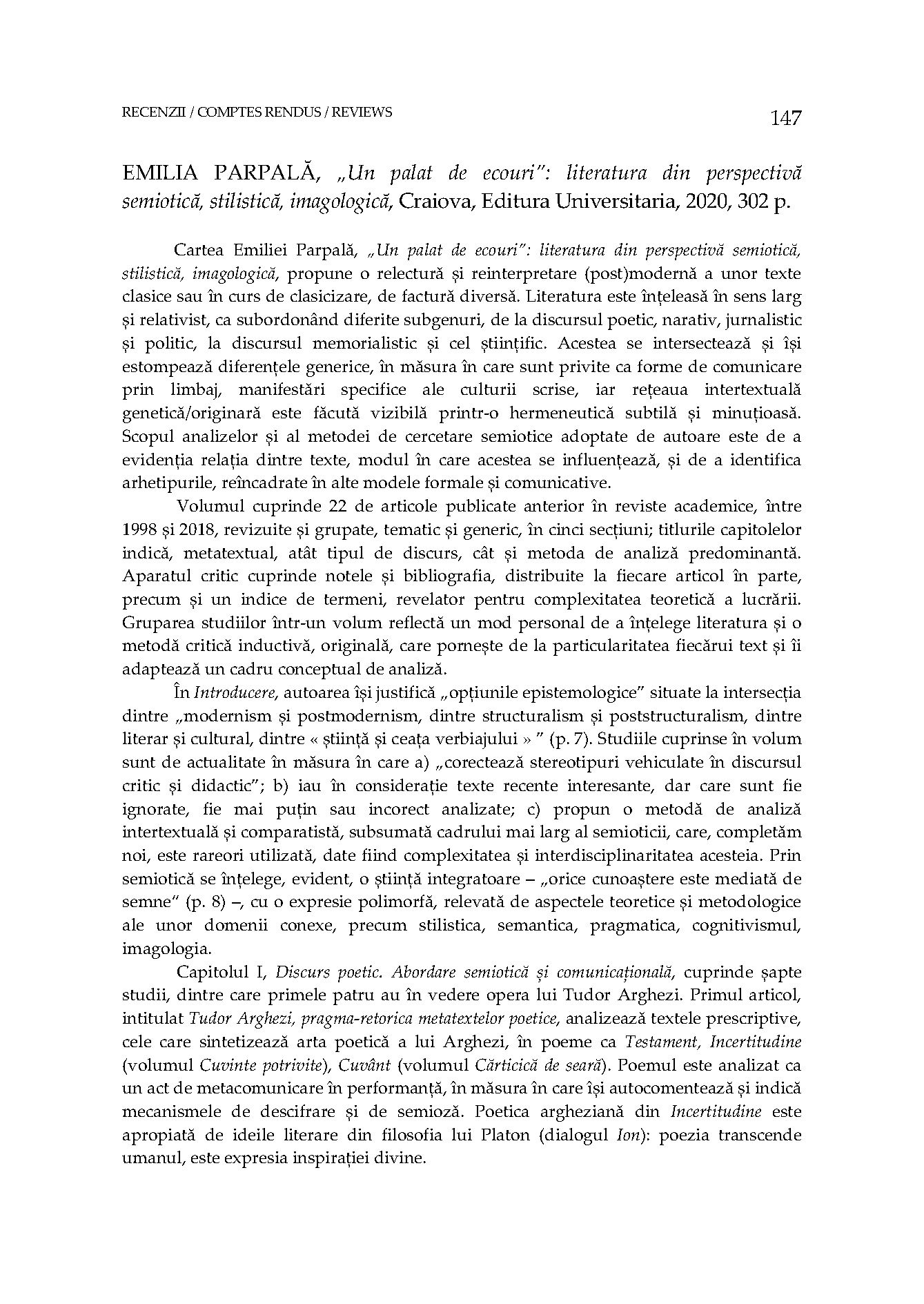Volum 71 Nr. 1 (2022): ANALELE UNIVERSITĂŢII BUCUREŞTI LIMBA ŞI LITERATURA ROMÂNĂ 2022
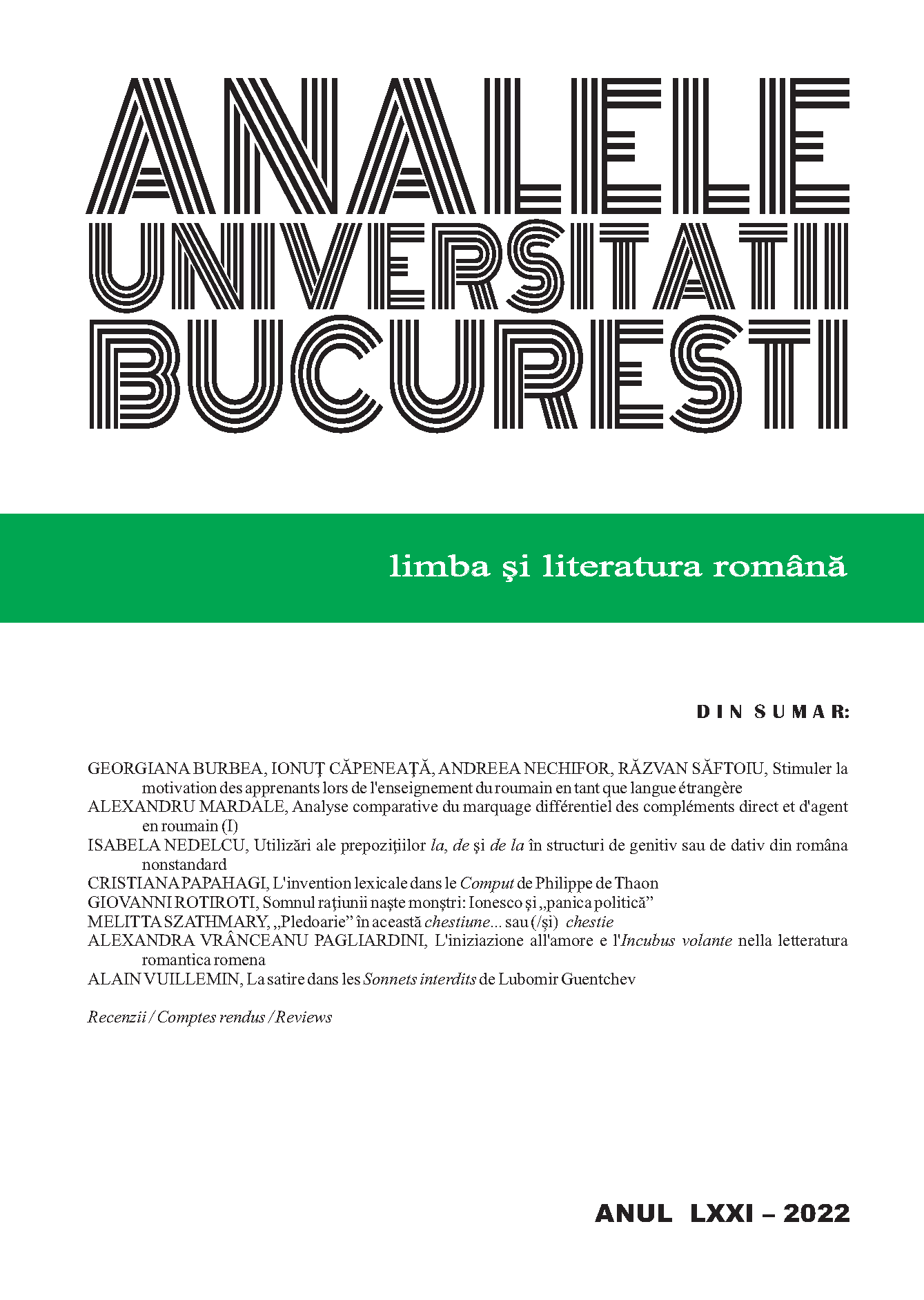
The journal Analele Universităţii Bucureşti. Limba şi literatura română [Annals of the University of Bucharest. Romanian Language and Literature] publishes articles and reviews dealing with various and relevant philological topics in neighboring disciplines: linguistics regarding Romanian and/or other languages; Romanian literature; universal and comparative literature; theory of literature; Romanian and comparative folklore; cultural anthropology.
Articles
-
STIMULER LA MOTIVATION DES APPRENANTS LORS DE L’ENSEIGNEMENT DU ROUMAIN EN TANT QUE LANGUE ÉTRANGÈRE
Rezumat
Motivating the participants involved in the educational act represents nowadays a real challenge, both on the professors’ side and on the students’ side. The answers that can be provided today, in this way, must use a language as close as possible to the sphere of interest of those they are addressed to. Consequently, in what the students are concerned, concepts related to the digital era can have a real and successful impact. That is why, the implementation of the concept of gamification in the teaching-learning process, especially in a multicultural context, represented an extremely useful and interesting experiment at the Preparatory Year focused on teaching Romanian as a foreign language at the Faculty of Letters of Transilvania University of Brașov, as part of the GIRO national project. Its results confirmed the expectations, as student motivation was boosted to such an extent that it surpassed the few negatives encountered on the way, the combination of game-based activities and the gamified vision being at its best.
-
ANALYSE COMPARATIVE DU MARQUAGE DIFFÉRENTIEL DES COMPLÉMENTS DIRECT ET D’AGENT EN ROUMAIN (I)
Rezumat
This article examines Differential (Direct) Object (DOM) and Agent Marking (DAM) in (contemporary) Romanian on the basis of written data coming mostly from the internet. It shows that both phenomena are optional (with some exceptions for certain types of Direct Objects) and that they are both triggered by the parameter of animacy which is a necessary one. While DOM may additionally be triggered by specificity and topicality, DAM is not sensitive to specificity and it may be affected by language register (namely the official / administrative register).
-
UTILIZĂRI ALE PREPOZIȚIILOR LA, DE ȘI DE LA ÎN STRUCTURI DE GENITIV SAU DE DATIV DIN ROMÂNA NONSTANDARD
Rezumat
In the present article the author describes the use of the prepositions la, de, and de la in genitive or dative structures, encountered in the regional varieties of Romanian, emphasizing the frequency of the aforementioned structures and their specific features as shown in the corpus of dialectal texts investigated.
The author also illustrates and discusses the different stages of grammaticalization of the preposition la in the expression of the genitive and dative and the connection between the genitive/dative relation and the locative relation.
-
L’INVENTION LEXICALE DANS LE COMPUT DE PHILIPPE DE THAON
Rezumat
The paper analyses the way Philippe de Thaon presents his many lexical inventions in the Comput (an astronomical treatise composed in 1113 or 1119). In the peculiar context of the first half century of Norman England, Philippe draws upon the local tradition of translating into the vernacular, but with the purpose of imposing his own vernacular as a prestige language. He invents French words close to Latin, emphasizes the language he is using (en francesche raisun), and deliberately creates confusion between Latin and French forms. Philippe’s Comput thus functions as a handbook of scientific French, and as an instrument for the cultural policy of the first Anglo-Norman rulers.
-
SOMNUL RAŢIUNII NAŞTE MONŞTRI: IONESCO ŞI „PANICA POLITICĂ”
Rezumat
Starting from the thought of Jean-Luc Nancy and Lacoue-Labarthe, this article aims to investigate the “political panic” that arises at the crossroads of identification and narcissism. These redefine the place of the Other in the formation of society, from the intersection between the individual psyche and collective life, where life appears to be committed to defending itself, in an autoimmunizing movement, which (to the extent that it defends itself) tends to reverse itself into its opposite. The radicalization of the self-preservation drives coincides in Freud works with the “death drive”, whose
movement appears regressive, aimed at restoring the restlessness of life to its original state of rest. Instead of opening itself to the Other, life closes itself and chooses death. Nancy and Lacoue-Labarthe were able to grasp in the “political panic” the fragile relationship between the “withdrawal of the politician” and the beginning of politics, and this particular aspect of life in common also concerns the play of Ionesco, Rhinocéros. The Romanian writer denounces in France the fascist ideological contagion of a whole generation of writers, between the two wars, highlighting the “death drive”, which moves the coryphes of political totalitarianism in Romania towards the spasmodic competition, fanaticism, cynicism, and, in some cases, towards crime. It is imaginatively cloaked in religious idealism understood as an all- encompassing “spiritual” knowledge, free of stretch marks. -
„PLEDOARIE” ÎN ACEASTĂ CHESTIUNE... SAU (/ȘI) CHESTIE
Rezumat
The aim of this paper is to examine the current use of the terms chestiune and chestie, in order to highlight their common and different features. Since the study is qualitative in nature, the descriptive method is employed for analysis and interpretation. The article mainly focuses on the semantic dynamics of the noun chestie, so as to introduce and discuss it as an independent lexeme, and not as a variant.
The examples have been taken from web-based sources such as blogs, discussion forums, websites, online media and readers’ comments on journal articles, social media sites and apps, etc. There are two stages in this approach: the first one corresponds to the year 2013 (presentation of partial results) and the second one is based on research for the years 2021-2022. -
L’INIZIAZIONE ALL’AMORE E L’INCUBUS VOLANTE NELLA LETTERATURA ROMANTICA ROMENA
Rezumat
The object of my analysis is the fantastic character of the Flying Incubus, known in the Romanian folklore as the Sburător [The Flyer], reinterpreted by three Romantic poets, I. Heliade Rădulescu, Cezar Bolliac, and V. Alecsandri. In their poems that share the same title, Sburătorul, they associate different values to this character, commonly seen as a seducer of young girls, appearing to them at night and consuming them with a strange passion that can lead to the girls’ death: for Heliade Rădulescu, the Flying Incubus is very similar to a vampire, Alecsandri depicts him as a sort of fawn, whereas in Bolliac’s poem he is an erotic demon. This character’s recurrence in Romanian 19th century literature is an influence of the Romanticism from two points of view: the discovery of the folklore as a source of poetic inspiration and the attraction for dark love, as analyzed by Mario Praz.
-
LA SATIRE DANS LES SONNETS INTERDITS DE LUBOMIR GUENTCHEV
Rezumat
In Lubomir Guentchev's Sonnets Interdits [Forbidden Sonnets], the satire is very violent. The poet protests in French, as well as in Bulgarian, against the oppression of the human being that he had witnessed in his country, during the totalitarian period, starting with 1946. He created a first series between 1972 and 1973. These first sonnets were confiscated from him on October 18, 1973, during a political police search. He was refused their restitution. A second part of these poems was created between 1974 and 1980. They were found between 2001 and 2004, when the archives of the Bulgarian Ministry of the Interior were opened. The whole series was published in France in 2005. These Sonnets Interdits cry out his revolt against the regime established at that time in Bulgaria. The poet expresses his indignation by resorting to a virulent, vehement satire. What are the specific intentions, the targets and the means of expression?
Book Reviews
-
MONA MOMESCU, EDUARD ANDREI, Risipitorul de talent: Ilie Cristoloveanu, pictor și filolog în România și SUA [The Prodigal Prodigy Ilie Cristoloveanu, an Artist and Philologist in Romania and the USA] Bucharest, Paideia, 2022, 522 p., with ill
Rezumat
Ilie Cristoloveanu (1893-1964), an artist trained in fine arts in the Belle Époque Romania, has recently made the subject of a consistent monograph written by philologist Mona Momescu and art historian Eduard Andrei. The artist’s archive and
quasi-complete donation of works (about two hundred paintings, sketches, drawings, portraits), were identified in 2021 at the Romanian National Museum of Art in Bucharest. They came to the museum’s collection after a last-minute decision of the artist’s late wife Olga Cristoloveanu – herself an art lover, a soprano and her husband’s muse – to donate them in 1977 to a Romanian museum, against her husband’s anti- Communist will. Olga Cristoloveanu, a voluntary character, outlived her husband more than two decades and tried to leave his inheritance to Columbia University, New York, where her husband had lived and worked. Eventually, she donated the works to probably the most visible museum in Romania, which now appears to have been a wise decision, as it offered the artworks better visibility and recognition. The volume also includes a consistent corpus of images taken after the main assets of this archive. -
René GIRARD, O teorie a miturilor arhaice și moderne traducere din limba franceză de Marinela Blaj, Iași, Editura Cartea Românească Educațional, 2021, 268 p
Rezumat
Teoria mimetică formulată de René Girard în Minciună romantică și adevăr romanesc (1961) și în Violența și sacrul (1972) a apărut ca o posibilitate de interpretare culturală a scenariului general al rivalității. În ultimele decenii, urmare a unui reducționism asumat al modelului său teoretic, pe care Girard l-a socotit, însă, firesc, această propunere pare că a evoluat, tocmai în virtutea simplității sale, sub spectrul unei prejudecăți prin care i-a fost limitată relevanța la structuri antropologice tipice culturilor arhaice. Mimetismul primar ce animă comunități largi se naște în contextul identificării unui pericol colectiv, ce generează un soi de iminență ontologică, prin care se impune desemnarea imediată, fie și scurtcircuitând criterii raționale, a unui vinovat, a unui țap ispășitor, frecvent numit aleatoriu, ce trebuie sacrificat, pentru ca ordinea să fie reinstalată în comunitatea temporar perturbată. Teoria propusă de René Girard derivă din interpretarea unor reacții psihologice necontrolate, prin care se creează spontan rețele și grupuri, ce permit individului să se delimiteze de o responsabilitate subiectivă. Scenariile de persecuție colectivă, pe care Girard le explică într-o formă extinsă în Țapul ispășitor (1982), sunt evocate în Teoria miturilor arhaice și moderne, întărind ideea autorului, conform căreia teoria mimetică trebuie să reacționeze „împotriva tendinței secolului al XX-lea de a vedea peste tot numai ficțiune”. De aici și valoarea testamentară a poziției lui René Girard, care declară, în prefața-program a eseurilor sale, că s-a străduit, de-a lungul timpului, să asculte și să transcrie „o voce disprețuită/negată a realului”.
-
EMILIA PARPALĂ, „Un palat de ecouri”: literatura din perspectivă semiotică, stilistică, imagologică Craiova, Editura Universitaria, 2020, 302 p.
Rezumat
Cartea Emiliei Parpală, „Un palat de ecouri”: literatura din perspectivă semiotică, stilistică, imagologică, propune o relectură și reinterpretare (post)modernă a unor texte clasice sau în curs de clasicizare, de factură diversă. Literatura este înțeleasă în sens larg și relativist, ca subordonând diferite subgenuri, de la discursul poetic, narativ, jurnalistic și politic, la discursul memorialistic și cel științific. Acestea se intersectează și își estompează diferențele generice, în măsura în care sunt privite ca forme de comunicare prin limbaj, manifestări specifice ale culturii scrise, iar rețeaua intertextuală
genetică/originară este făcută vizibilă printr-o hermeneutică subtilă și minuțioasă. Scopul analizelor și al metodei de cercetare semiotice adoptate de autoare este de a evidenția relația dintre texte, modul în care acestea se influențează, și de a identifica arhetipurile, reîncadrate în alte modele formale și comunicative. -
STEPHAN BLATTI, SANDRA LAPOINTE (eds.), Ontology after Carnap Oxford, Oxford University Press, 2016, 253 pp.
Rezumat
Ontology after Carnap [Ontologia după Carnap] pune în discuție multiple aspecte ale teoriei lui Carnap, comparând viziunile din lucrări diferite ale gânditorului: Sintaxa logică a limbii (1934), Semnificație și necesitate (1947) și, cu precădere, Empirism, semantică și ontologie (1950). Cartea de față cuprinde o analiză complexă a unor concepte filosofice dezvoltate în cel mai important episod din istoria ontologiei moderne, anume dezbaterea dintre Rudolf Carnap (1891–1970) și Willard van Orman Quine (1908–2000). Dezbaterea a fost inițiată de studiul lui Quine, On what there is (1948), ca răspuns la scrierile lui Carnap. Temele supuse dezbaterii au fost natura angajamentului ontologic și existența
entităților abstracte ca numere, propoziții, clase, proprietăți și relații. Pentru a discuta problema existenței entităților, Carnap întrebuințează termenii linguistic framework „carcasă lingvistică” și questions „chestiuni”1. El face o distincție între chestiunile interne și externe. Chestiunile interne au în vedere existența anumitor entități înăuntrul carcasei
lingvistice, sunt puse și primesc răspuns în interiorul acesteia, întrucât sunt supuse unor reguli, iar adevărul lor poate fi verificat prin metode logice sau empirice. De exemplu, propoziția There are numbers „Există numere?” rezultă analitic din propozițiile: There are five books on the table „Sunt cinci cărți pe masă”; Five is a number „Cinci este un număr”.
Chestiunile externe au în vedere existența sau realitatea sistemului de entități în ansamblu, nefiind discutate de oamenii de știință, ci de filosofi. Acceptarea existenței unui anumit tip de entități înseamnă acceptarea unui anumit tip de limbaj, a unei carcase lingvistice.


